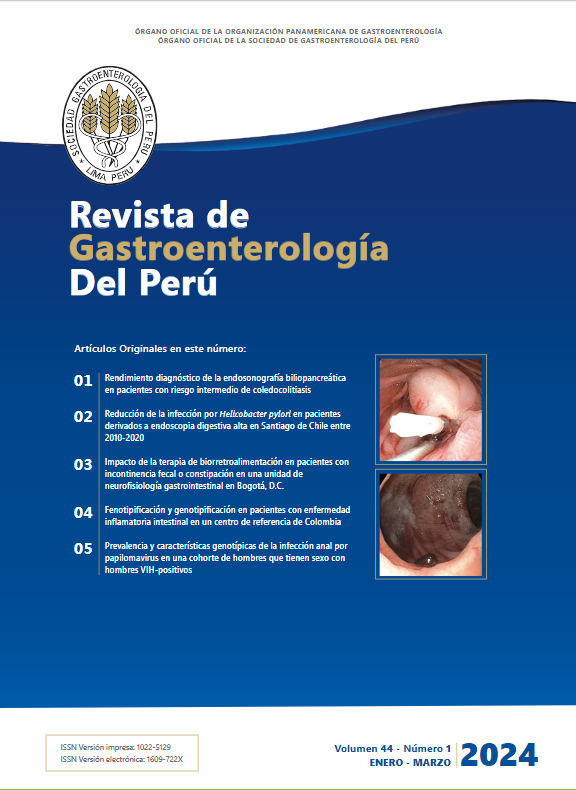Impact of biofeedback therapy on patients with fecal incontinence or constipation in a gastrointestinal neurophysiology unit in Bogotá, D.C.
DOI:
https://doi.org/10.47892/rgp.2024.441.1557Keywords:
Constipation, Fecal incontinence, DefecationAbstract
Introduction: Treatment of functional disorders of the anorectal unit should focus on the underlying cause. Biofeedback therapy is a functional retraining of the pelvic floor that has proven useful in the treatment of constipation associated with dyssynergia and in the management of fecal incontinence. This study describes the first experiences with this form of biofeedback therapy in Colombia. Objective: Describe our experience with biofeedback therapy in the gastrointestinal neurophysiology unit. Materials and methods: This historical cohort included patients with an indication for biofeedback therapy for constipation or fecal incontinence in the gastrointestinal neurophysiology unit during the data collection period. The response to therapy is described by comparing manometric findings before and after 10 biofeedback sessions. Results: 21 patients were included (71.4% women, the average age was 68, 9 with constipation and 12 with fecal incontinence. Among the patients with constipation there was a significant improvement in 71.4% of those who had rectal hyposensitivity and in 57.1% of those with dyssynergia. Biofeedback therapy significantly increased the balloon expulsion rate (11.1 vs. 66.7%, p=0.02). In patients with fecal incontinence, there was improvement in 50% of those who had anal hypotonia and in 80% of those who had anal hyposensitivity. Conclusions: This study demonstrates that biofeedback therapy has a favorable impact on a high number of patients with constipation and fecal incontinence; in our center, the response is similar to that of the world literature.
Downloads
Metrics
References
Carrington EV, Heinrich H, Knowles CH, Fox M, Rao S, Alto- mare DF, et al. The international anorectal physiology working group (IAPWG) recommendations: Standardized testing pro- tocol and the London classification for disorders of anorectal function. Neurogastroenterol Moti. 2020;32(1):e13679. doi: 10.1111/nmo.13679.
Harris LA. Prevalence and ramifications of chronic constipa- tion. Manag Care Interface. 2005;18(8):23-30.
Sobrado CW, Neto IJFC, Pinto RA, Sobrado LF, Nahas SC, Ce- cconello I. Diagnosis and treatment of constipation: a clini- cal update based on the Rome IV criteria. J Coloproctology. 2018;38(02):137-44.
Saldana Ruiz N, Kaiser AM. Fecal incontinence - Challenges and solutions. World J Gastroenterol. 2017;23(1):11-24. doi: 10.3748/wjg.v23.i1.11.
Garcia-Armengol J, Moro D, Ruiz MD, Alos R, Solana A, Roig- Vila JV. Defecacion obstructiva. Metodos diagnosticos y trata- miento. Cir Esp. 2005;78(supl.3):59-65.
Rao SSC, Patcharatrakul T. Diagnosis and treatment of dyssyn- ergic defecation. J Neurogastroenterol Motil. 2016;22(3):423– 35. doi: 10.5056/jnm16060.
Mearin F, Ciriza C, Mínguez M, Rey E, Mascort JJ, Peña E, et al. Guía de Práctica Clínica: Síndrome del intestino irritable con estreñimiento y estreñimiento funcional en adultos. Rev Esp Enferm Dig (Madrid). 2016;108(6):332-363.
Chiarioni G, Whitehead WE, Pezza V, Morelli A, Bassotti G. Biofeedback is superior to laxatives for normal transit con- stipation due to pelvic floor dyssynergia. Gastroenterology. 2006;130(3):657-64. doi: 10.1053/j.gastro.2005.11.014.
Lanagrán ML, Romero Ordoñez MA, Aisa ÁP. Enfoque diag- nostico terapéutico en disinergia defecatoria. Revista andalu- za de patología digestiva. 2013;36(4):231-6.
Delgado Villarreal AF, Costa Barney VA, Hani de Ardila AC, Le- guízamo Naranjo AM, Ardila Hani AF, Meza Madrid D. Actua- lización con la clasificación de Londres en la interpretación de la manometría anorrectal de alta resolución. Rev Colomb Gastroenterol. 2019;34(4):411-5. doi: 10.22516/25007440.484
SkardoonGR,KheraAJ,EmmanuelAV,BurgellRE.Reviewarticle: dyssynergic defaecation and biofeedback therapy in the patho- physiology and management of functional constipation. Aliment Pharmacol Ther. 2017;46(4):410-23. doi: 10.1111/apt.14174.
Chiarioni G. Bio-feedback treatment of fecal incontinence: Where are we, and where are we going? World J Gastroen- terol. 2005;11(31):4771-5. doi: 10.3748/wjg.v11.i31.4771.
McKee RF, McEnroe L, Anderson JH, Finlay IG. Identifica- tion of patients likely to benefit from biofeedback for outlet obstruction constipation. Br J Surg. 2003;86(3):355-9. doi: 10.1046/j.1365-2168.1999.01047.x.
Lau C-W, Heymen S, Alabaz O, Iroatulam AJN, Wexner SD. Prognostic significance of rectocele, intussusception, and ab- normal perineal descent in biofeedback treatment for consti- pated patients with paradoxical puborectalis contraction. Dis Colon Rectum. 2000;43(4):478-82. doi: 10.1007/BF02237190.
Rao SSC, Valestin JA, Xiang X, Hamdy S, Bradley CS, Zimmer- man MB. Home-based versus office-based biofeedback thera- py for constipation with dyssynergic defecation: a randomised controlled trial. Lancet Gastroenterol Hepatol. 2018;3(11):768- 77. doi: 10.1016/S2468-1253(18)30266-8.
Downloads
Published
How to Cite
Issue
Section
License
Copyright (c) 2024 Mauricio Daza Castro, Albis Cecilia Hani, Oscar Muñoz, Fredy Avila

This work is licensed under a Creative Commons Attribution 4.0 International License.
Revista de Gastroenterología del Perú by Sociedad Peruana de Gastroenterología del Perú is licensed under a Licencia Creative Commons Atribución 4.0 Internacional..
Aquellos autores/as que tengan publicaciones con esta revista, aceptan los términos siguientes:
- Los autores/as conservarán sus derechos de autor y garantizarán a la revista el derecho de primera publicación de su obra, el cuál estará simultáneamente sujeto a la Licencia de reconocimiento de Creative Commons que permite a terceros compartir la obra siempre que se indique su autor y su primera publicación esta revista.
- Los autores/as podrán adoptar otros acuerdos de licencia no exclusiva de distribución de la versión de la obra publicada (p. ej.: depositarla en un archivo telemático institucional o publicarla en un volumen monográfico) siempre que se indique la publicación inicial en esta revista.
- Se permite y recomienda a los autores/as difundir su obra a través de Internet (p. ej.: en archivos telemáticos institucionales o en su página web) antes y durante el proceso de envío, lo cual puede producir intercambios interesantes y aumentar las citas de la obra publicada. (Véase El efecto del acceso abierto).

















 2022
2022 